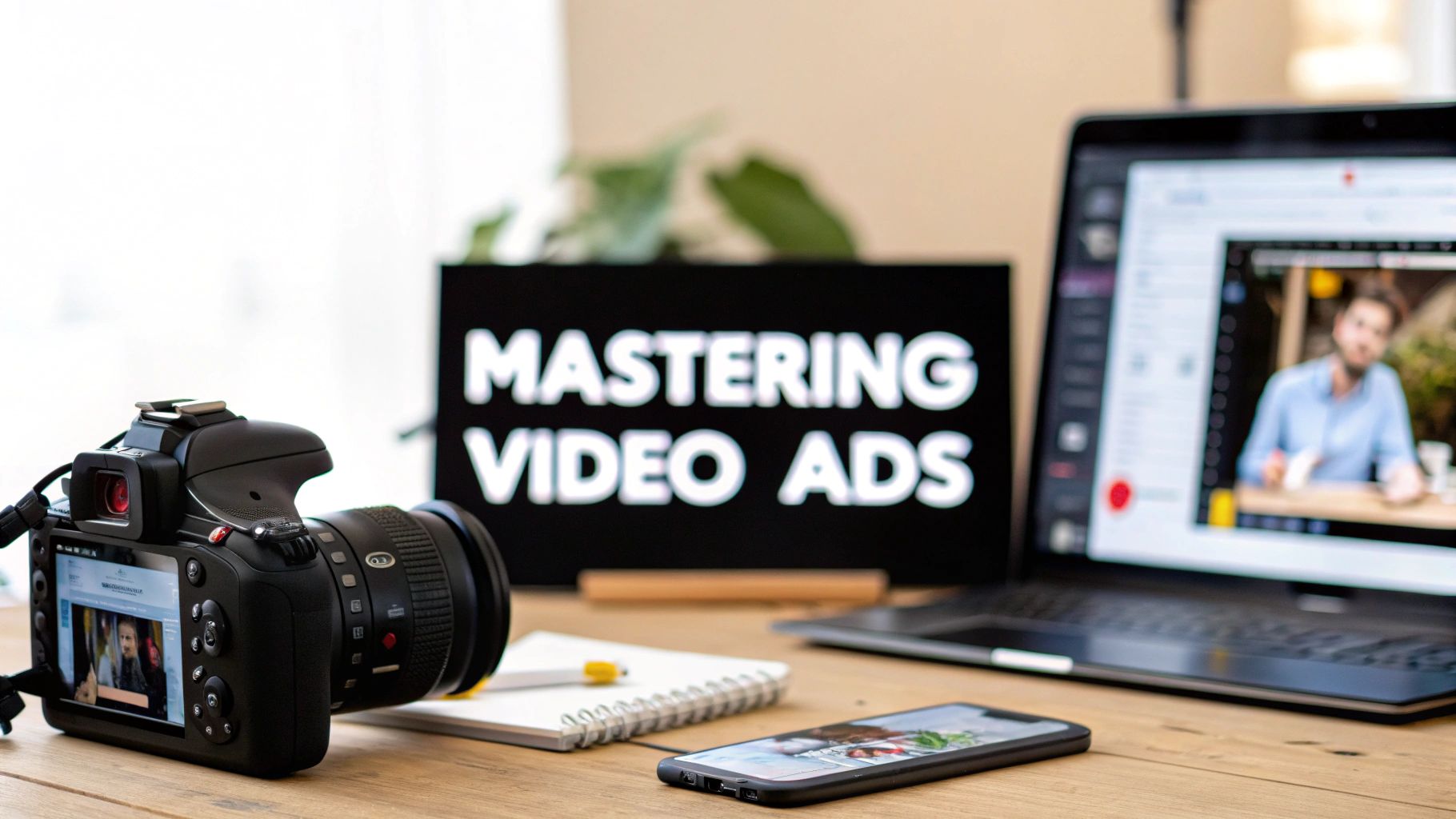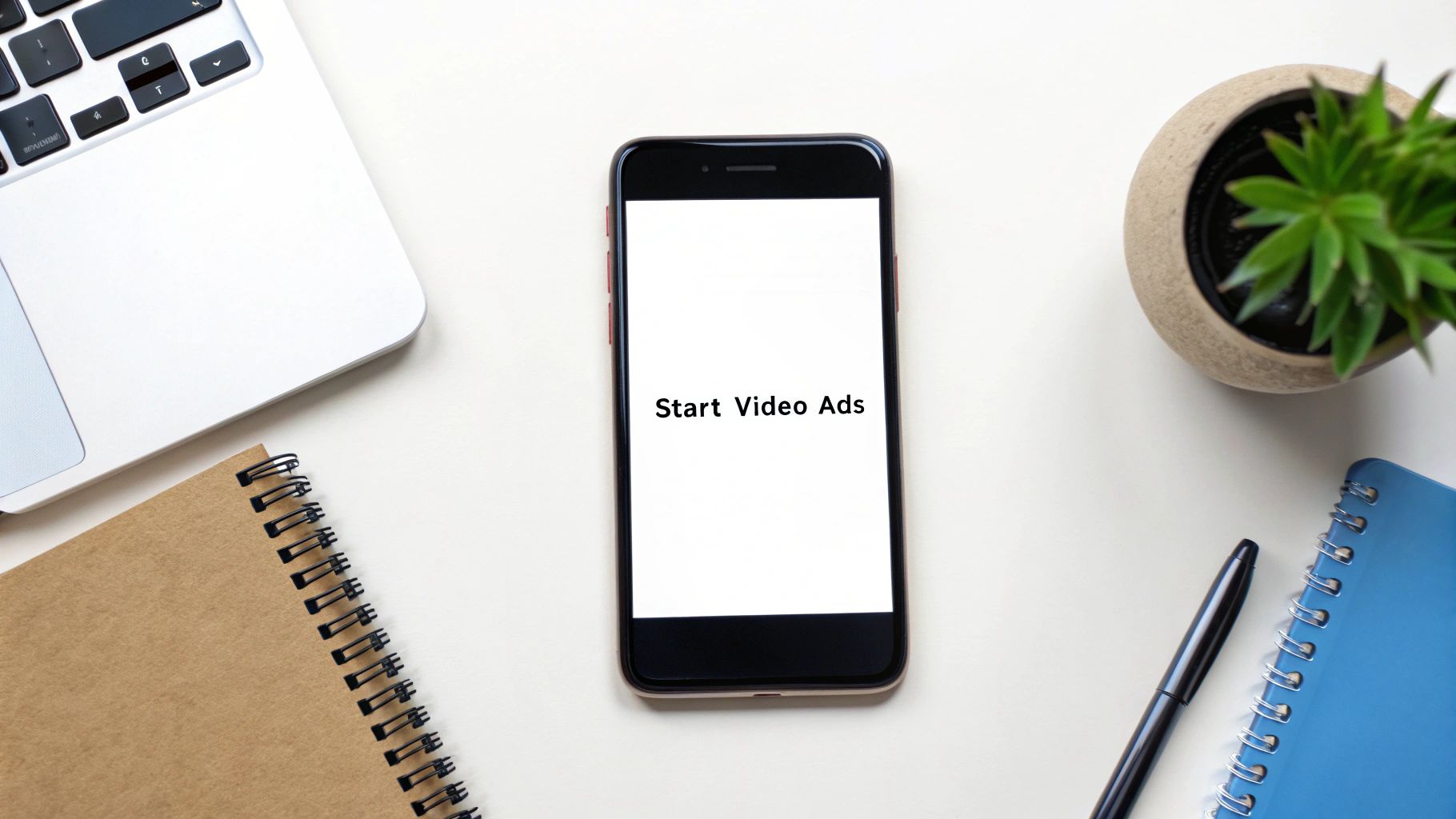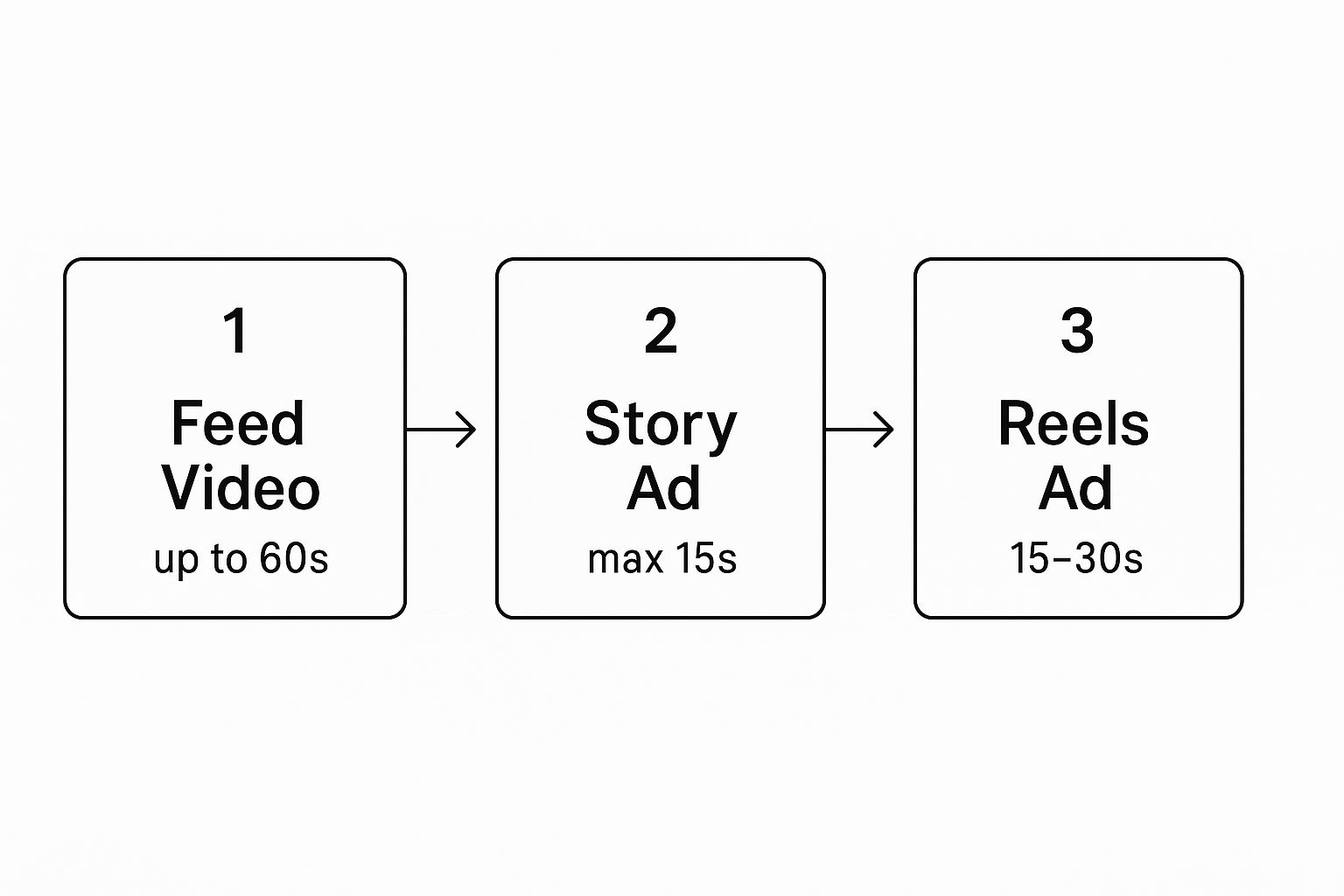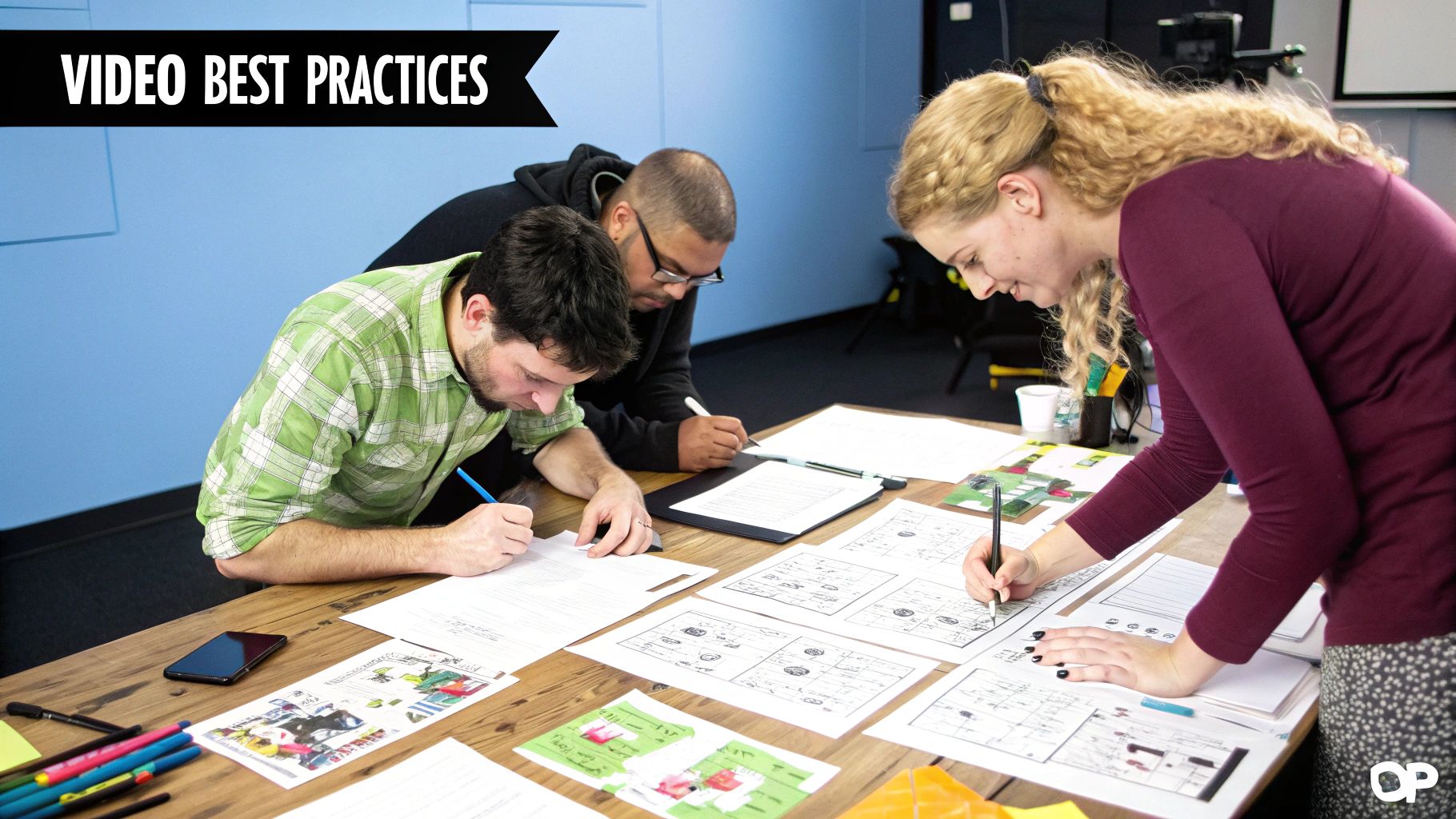
Mastering Video Ads for Instagram
Create high-converting video ads for Instagram. This guide provides actionable strategies for planning, AI-powered creation, and campaign optimization.
Let's be honest, running video ads on Instagram isn't just a "nice to have" anymore—it's how you actually get results. A great video can stop someone mid-scroll, get your point across in just a few seconds, and drive sales in a way that static images just can't match.
Why Instagram Video Ads Are Your Growth Engine

The reality is, static images have lost their punch. People’s habits have changed, and everyone's attention has gravitated toward quick, dynamic video, thanks in large part to Instagram Reels and Stories. This isn't just a fleeting trend; it’s a fundamental shift in how we all consume content and decide what brands to trust.
This matters because Instagram's algorithm rewards content that keeps people on the app. By its very nature, video is more captivating and holds attention far longer than a still photo. When you run video ads for Instagram, you're playing the game the way Instagram wants you to play it, which gives your brand a serious advantage.
Building a Real Connection
Video lets you tell a story, show off a product from every angle, and share real human emotion. You can't get that from a block of text or a simple picture. This is where you build a genuine connection, whether it’s through a behind-the-scenes glimpse of your workshop, a heartfelt customer review, or a quick-and-dirty tutorial.
That connection translates directly to your bottom line. The numbers don't lie. As of 2025, videos account for around 60% of the time people spend on Instagram. Even better, a massive 76% of marketers say Instagram delivers the best ROI specifically from its video ad formats.
High-Quality Video is No Longer Out of Reach
Not long ago, creating a professional-looking video ad meant a huge budget and hiring a whole production crew. That’s not the case anymore. The barrier to entry has completely disappeared.
Tools like ViewPrinter leverage AI to make the entire process incredibly simple, from brainstorming script ideas to putting the final edits on your video. This means even small businesses and one-person shops can now create polished, high-converting video ads without breaking the bank. You can see just how powerful this is by learning more about how to monetize Instagram Reels in our dedicated guide.
The real magic of video isn't just that it looks good. It's the ability to deliver a complex message in a way that’s fast, clear, and memorable. In a feed packed with distractions, that's what turns a casual scroll into a real customer.
To really capitalize on this, it helps to understand the fundamentals of effective video marketing strategies for small businesses. When you pair those time-tested strategies with the powerful tools available today, you’ve got everything you need to build a powerhouse for growth on Instagram.
Building Your Campaign Foundation

Before a single frame is shot or a line of copy is written, the fate of your video ads for Instagram is sealed right here, in the planning phase. Jumping into ad creation without a solid strategy is like building a house without a blueprint. It's messy, expensive, and the whole thing is likely to collapse.
This initial groundwork is what ensures every ad dollar you spend is pulling its weight.
First things first: you need to decide exactly what you want this ad to accomplish. "Getting more sales" is a wish, not an objective. A strong objective is specific, measurable, and tied directly to a real business outcome. When your goals are vague, your results will be too, and you’ll have no real way of knowing if your campaign was a success.
Let's get specific. Trying to drive traffic to a new product page? Your objective is to get as many link clicks and landing page views as possible. Aiming to grow your email list? Then your entire focus should be on lead form submissions. This clarity is crucial—it informs every decision you’ll make down the line, from your call-to-action to the metrics you obsess over.
Defining Your Ideal Customer
Once you’ve got your "what," it’s time to nail down your "who." Targeting "women aged 25-40" is casting a net far too wide. You need to create a detailed persona of one specific person. What keeps them up at night? What are their biggest frustrations that your product can actually solve?
Move beyond the basic demographics and get into psychographics—their values, interests, and how they behave online.
- Pain Points: What problem are you truly solving? A skincare company isn’t just selling moisturizer; it’s selling confidence to someone who feels insecure about their dry skin.
- Aspirations: What's the dream outcome they're chasing? A fitness app isn't selling workout routines; it's selling the feeling of accomplishment and a healthier future.
- Content Habits: Where are they on Instagram? Do they follow certain influencers, binge-watch specific types of Reels, or save educational carousels?
This deep-dive is your creative goldmine. It lets you craft a message that speaks their language and makes your ad feel less like an annoying interruption and more like a genuinely helpful suggestion.
Your ad isn't for everyone. It's for your someone. The more precisely you can picture that one ideal customer, the more powerfully your message will resonate with thousands just like them.
Crafting a Message That Stops the Scroll
Let’s be real: you have maybe three seconds to stop someone from scrolling past your ad. That’s it. The first frame, the first sound, the initial movement—it all has to work together to create a hook that's impossible to ignore. Your message can't be a slow burn; it needs to spark immediate curiosity or deliver instant value.
A powerful hook usually does one of three things:
- Asks a relatable question: "Tired of your houseplants always dying?"
- Makes a bold promise: "This is the last water bottle you'll ever buy."
- Shows a surprising visual: Think of a jaw-dropping "before and after" or a product being used in a completely unexpected way.
Once you have their attention, your core message needs to be ruthlessly simple. Don't try to cram five different benefits into 15 seconds. Pick the one thing that matters most to the customer persona you just built and hammer it home. If your ideal customer is all about sustainability, your message should be about your eco-friendly materials—not your free shipping or rainbow of color options.
This disciplined approach—objective, audience, and message—is the bedrock of any Instagram video ad that gets results. It turns your ad from a shot in the dark into a calculated play designed for impact. With this foundation solid, you're ready to start bringing your vision to life.
Creating Your Video Ad with AI Tools
With a solid strategy in place, it's time for the fun part: actually making your video. This is where your ideas jump off the whiteboard and become a polished ad ready for Instagram. If you don't have a video editing background, don't sweat it. AI-powered tools like ViewPrinter make the whole creation process incredibly fast and straightforward.
From Raw Assets to a Polished Ad
Your first move is to give the AI your raw materials. This can be a mix of anything you have on hand—professional product shots, quick clips from your phone, or even user-generated content you've collected. Just think of it as handing over the building blocks.
Let’s say you're an e-commerce brand selling handcrafted leather bags. You might upload a folder with:
- Five high-res photos of your best-selling tote.
- A 10-second close-up clip of the bag's detailed stitching.
- A short video testimonial from a happy customer.
From just these few assets, the AI gets to work. Instead of you facing a blank screen, ViewPrinter's script generator can analyze your campaign goals and target audience to spit out several compelling script ideas. It might suggest one script focusing on durability and another centered on style, giving you instant creative directions to choose from.
Once you’ve picked a script, the AI can map out a storyboard concept. This is a huge help. It gives you a visual outline of how the ad will flow, shot by shot, before you commit to any editing. It intelligently sequences your footage and images to match the story, making sure it makes sense and hits all the right notes.
Now you can jump into the AI editor, where ViewPrinter really shines as your personal editing assistant. It can intelligently trim your clips, picking out the most engaging moments and ditching any awkward pauses or shaky footage.
The AI also automatically generates accurate, easy-to-read captions. Since a massive chunk of users watch videos on mute, this feature is absolutely essential for creating effective video ads for Instagram.
The dashboard below gives you a feel for how an AI editor centralizes everything—your timeline, asset library, and preview window are all in one spot.

This setup gives you total control while the AI handles the heavy lifting.
To top it all off, the tool can suggest royalty-free music that fits the mood of your ad, whether you want something upbeat or more sophisticated. This completely removes the headache of digging through music libraries and stressing about copyright. If you're curious about how this all works behind the scenes, you can learn more about the mechanics behind https://viewprinter.tech/blog/articles/ai-video-ads.
Adapting Your Video for Every Placement
Here's a hard truth: a single video rarely works perfectly across all of Instagram's different formats. A 60-second landscape video that looks great in the main feed will fall flat as a 15-second vertical Story. This is where AI-powered reformatting is a total game-changer.
Instead of manually re-editing your video for each placement, a tool like ViewPrinter can do it for you in a few clicks. It automatically crops, resizes, and even re-orders scenes to create optimized versions for:
- Instagram Feed: The classic square or vertical format, up to 60 seconds.
- Instagram Stories: A full-screen vertical format, where ads are typically 15 seconds.
- Instagram Reels: A full-screen vertical format, with ads running between 15-30 seconds.
The goal isn't just to make the video fit the dimensions; it's to make it feel native to the placement. AI helps you do this at scale, ensuring your ad looks professional and performs well, no matter where your audience sees it.
This adaptability has become more critical than ever, especially with the explosion of short-form video. Since their 2020 launch, Instagram Reels have become a powerhouse. In fact, by 2025, ads on Reels are projected to reach around 726.8 million users—that's over half of Instagram’s total ad audience. This kind of reach makes Reels an essential part of any modern video ad strategy.
While AI tools are incredibly powerful, pairing them with authentic user-generated content can make your ads even more persuasive. Beyond AI, checking out the Best UGC Creator Tools can help you source and manage content from real customers, seriously boosting your ad's quality. This blend of AI efficiency and human authenticity is a potent formula for high-converting video ads.
Getting Your Campaign Live in Ads Manager

Alright, your video ad is polished and ready to go. Now for the final piece of the puzzle: getting everything set up inside Instagram's Ads Manager. This is where the rubber meets the road—where your strategy and creative finally come to life. It might look a little intimidating at first, but it really just boils down to a few key decisions.
The very first thing you have to lock in is your campaign objective. This is a big one. It's essentially you telling Instagram's algorithm what you want to achieve, and it will optimize everything around that single goal. Getting this right is absolutely critical.
For example, if you're trying to sell products directly from your e-commerce store, the Conversions objective is your best bet, hands down. But if you’re a brand-new business, your main goal might just be to get your name out there. In that case, something like Brand Awareness or Reach will serve you better, as they're designed to get your ad in front of the most eyeballs for the least amount of money.
Zeroing In on Your Audience
Remember that detailed customer persona we talked about building? This is where it pays off, big time. Ads Manager is where you bring that persona to life, telling Instagram exactly who needs to see your video ads for instagram. No more guesswork.
You get to layer different targeting options to build a super-specific audience.
- Demographics: You can go way beyond just age and gender. Think education level, relationship status, or even life events like a friend's upcoming wedding.
- Interests: This one is incredibly powerful. You can target people based on the brands they follow (like your competitors), magazines they read, or hobbies they're into.
- Behaviors: Here you can target users based on their online actions, like targeting "Engaged Shoppers"—people who have a history of clicking "Shop Now" buttons.
Let's say you're selling sustainable yoga mats. You could build an audience of women aged 25-45 who are interested in "Lululemon," "Yoga Journal," and "sustainable living," and then add the "Engaged Shopper" behavior on top. That level of precision is how you make sure your budget is working hard for you.
Think of targeting as a conversation. You're not shouting your message into a crowded room; you're whispering it directly to the person who has been waiting to hear it. The more specific you are, the more effective your ad will be.
Setting a Budget That Makes Sense
Next up is money: how much you're willing to spend and over what timeframe. Ads Manager gives you two main ways to handle this: a daily budget or a lifetime budget. There's no single "best" option; it really depends on your goals and how hands-on you want to be.
A daily budget is perfect for ongoing, "always-on" campaigns. You set a fixed amount to spend per day, and it's easy to tweak up or down as you see how things are performing. It's a solid, flexible choice, especially if you're just starting out.
A lifetime budget, on the other hand, gives the algorithm more leeway. You set a total budget for a specific date range, and Instagram will spend it for you—spending more on days it predicts will drive the best results. This works really well for short, time-sensitive promotions, like a weekend flash sale.
If you're not sure where to begin, a daily budget of $10-$20 is a realistic starting point. It's enough to start gathering meaningful data without a huge financial risk.
Assembling the Final Ad
This is the last mile. You'll upload the video you made with ViewPrinter, write your ad copy, and pick a call-to-action (CTA) button. Make sure your copy is short, punchy, and reinforces the message in your video.
That CTA button is more important than you think. Don't just leave it on the default "Learn More" unless that’s truly your goal. Be direct with options like:
- Shop Now
- Sign Up
- Download
- Watch More
Finally, and this is crucial, double-check that your tracking is set up. If you're driving traffic to your website, you absolutely need the Meta Pixel installed. This little snippet of code is how you'll track conversions, measure your return on ad spend (ROAS), and build powerful retargeting audiences down the line. Skipping this step is like flying blind.
With all that in place, you’re ready. Hit "Publish" and watch your campaign take flight.
How to Analyze and Optimize Your Ad Performance
So you've launched your video ad. Congratulations! But don't pop the champagne just yet. This is where the real work—and the real growth—begins. You have to listen to what the data is telling you and make smart, calculated adjustments. This is the difference between simply spending money and investing it.
Your ad performance isn't some black box; it's a story told through numbers. Learning to read that story is what separates campaigns that fizzle out from those that become predictable engines for your business.
Decoding Your Key Performance Metrics
Instead of getting swamped by every single data point Instagram throws at you, zoom in on the handful of metrics that actually matter. These are the numbers that paint a clear picture of what’s working and what’s broken.
The cost of advertising on Instagram can be a moving target. For instance, you might see a cost-per-click (CPC) anywhere from $0.20 to $2.00, and the average cost to reach 1,000 people (CPM) was sitting around $8.58 in early 2025. When you realize that typical ad conversion rates hover between 1% and 2%, it becomes crystal clear why every piece of your campaign needs to be dialed in for profitability. You can find more Instagram ad statistics on amraandelma.com to get a broader view.
Here are the big three I always keep my eyes on:
- Click-Through Rate (CTR): This is just the percentage of people who saw your ad and bothered to click. A low CTR is a massive red flag. It’s telling you that your video or your headline isn't doing its job of grabbing attention.
- Cost Per Click (CPC): Simple enough—this is what you pay for each click. If your CPC starts creeping up, it’s often because your ad is losing relevance with your audience, which means less engagement and higher costs for you.
- Return On Ad Spend (ROAS): This is the bottom line. For every dollar you put in, how many are you getting back? A ROAS under 1.0 is a losing game.
For a deeper look into these numbers and others you should be watching, we put together a guide on the most important social media metrics to track.
The A/B Testing Framework
Optimization isn't about guessing; it's about systematic experimentation. You need to prove what works better, and that’s exactly what A/B testing (or split testing) is for. The concept is simple: you create two almost identical ads, change just one thing, and see which version comes out on top.
Let me repeat that: never test more than one thing at a time. If you change the video, the headline, and the audience all at once, you’ll have no clue which change actually made the difference.
Here’s a practical way to approach it, one step at a time:
- Start with the Creative: Your video is the biggest lever you can pull. Test two completely different concepts. Maybe it's a fast-paced, high-energy product demo versus a slower, emotional customer testimonial. Let them fight it out.
- Test the Hook: Once you have a winning video style, isolate the first three seconds. Try starting one version with a direct question and another with a bold, surprising statement.
- Optimize the Ad Copy: With a winning video in hand, it’s time to look at the words. Test a short, punchy headline against a longer, more descriptive one to see what your audience responds to.
- Refine Your Audience: Finally, take your champion ad creative and test it against two different audiences. You could pit an interest-based audience ("loves yoga") against a lookalike audience you built from your existing customer list.
Think of A/B testing like a science experiment. You form a hypothesis ("I believe a testimonial video will convert better"), run the test, analyze the results, and let that knowledge guide your next move. This cycle is how you achieve constant improvement.
Knowing When to Scale and When to Kill
After a few days, your tests will start to show clear winners and losers. Being decisive with this data is what separates the pros from the people who just burn through their ad budget.
Signs it’s time to scale a winning ad:
- It's delivering a consistently high ROAS (I look for a 3.0 or higher).
- The CTR is strong while the CPC is low and stable.
- It’s bringing in a steady stream of conversions, day in and day out.
When you've got a winner, don't just dump a ton of money on it. Gently increase its daily budget by about 20% every few days. This avoids shocking the algorithm and lets you scale smoothly.
On the flip side, you have to be ruthless with the ads that aren't working.
Signs it’s time to kill a losing ad:
- It’s been running for 3-5 days with few or no conversions.
- The CTR is tanking compared to your other ads.
- The CPC is so high that you have no realistic path to profitability.
Don't get emotionally attached to a creative you loved. The data doesn't lie. Cut the loser, learn the lesson, and funnel that budget into your next test. This disciplined cycle of analyzing, testing, and optimizing is exactly how you turn your video ads for Instagram into a reliable growth channel for your business.
Got Questions About Instagram Video Ads? We've Got Answers.
Even the most seasoned marketers have questions when it comes to the nitty-gritty of Instagram video ads. It’s one thing to have a strategy, but it's another to get the details just right. Let’s clear up a few of the most common sticking points we see.
Think of this as your quick-reference guide to avoid those little mistakes that can sink an otherwise great campaign.
How Long Should My Video Ad Actually Be?
The real answer? It completely depends on where your ad shows up. There's no one-size-fits-all duration, and what works in the Feed will flop in a Reel. You have to play by the rules of the placement.
- For Reels and Stories: Go short. Really short. You’re aiming for the 15-30 second sweet spot. People are in a super-fast scroll mode here, so you need to get your point across and get out.
- For In-Feed Ads: You have a bit more breathing room. Up to 60 seconds can work, but only if you're telling a genuinely captivating story or doing a product demo that needs the extra time to build value.
Crucial Tip: No matter the length, your hook, your core message, and your brand have to be front-and-center within the first 3 seconds. If you don't stop the scroll instantly, the rest of the video is wasted because no one will stick around to see it.
Do I Really Need Sound in My Ads?
Here's a hard truth: a huge chunk of your audience will never hear your ad. They’re scrolling in a quiet office, on public transit, or next to a sleeping partner.
You absolutely must design your video to work with the sound off.
Use bold text overlays, strong visuals, and always, always include captions. Your message has to be 100% clear without a single note of audio. Think of sound as a nice bonus for the viewers who have their volume up—a good soundtrack can elevate the experience, but it should never be essential for understanding what you're offering.
What's a Realistic Starting Budget?
This is the million-dollar question, but the answer doesn’t have to be complicated. If you're just starting out, a budget of $10 to $20 per day is a smart, safe place to begin.
Why that range? It's enough cash to feed the Instagram algorithm the data it needs to start finding your ideal audience, but it's not so much that a few days of testing will break the bank.
Just be patient. Give any new campaign at least 3-5 days to run before you even think about touching it. This allows the ad to move past the initial "learning phase" so you can get a true read on performance. Then you'll have the data you need to decide whether to scale up, tweak it, or kill it.
Ready to create high-converting video ads for Instagram without the headache? ViewPrinter uses AI to help you generate compelling scripts, edit videos, and adapt them for every placement in minutes. Start building your next winning ad campaign today.